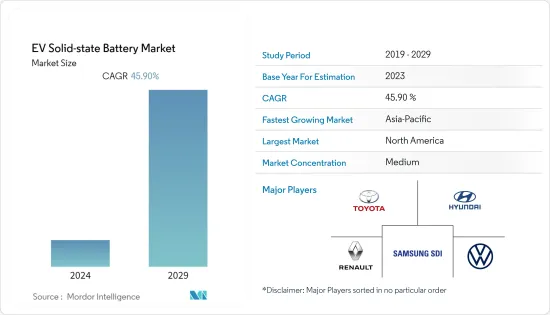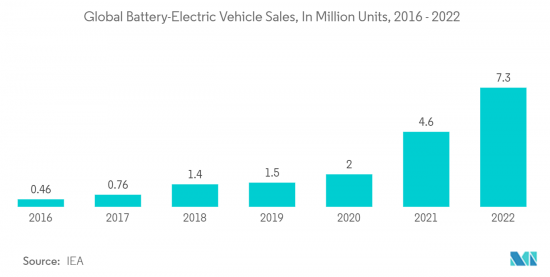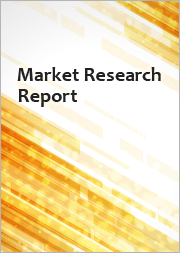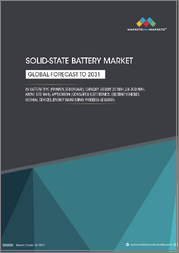
|
시장보고서
상품코드
1406910
세계 EV용 고체 전지 시장 - 점유율 분석, 산업 동향, 통계 및 성장 예측(2024-2029년)EV Solid-state Battery - Market Share Analysis, Industry Trends & Statistics, Growth Forecasts 2024 - 2029 |
||||||
EV용 고체전지 시장 시장 규모는 1억 8,300만 달러로 예측 기간 중 CAGR은 45.9%를 넘어 5년간 12억 1,400만 달러에 달할 것으로 예측되고 있습니다.

주요 하이라이트
- COVID-19 팬데믹은 당초 제조유닛의 가동정지와 록다운으로 인해 2020년 상반기 매출이 감소하여 시장에 부정적인 영향을 미쳤습니다. 그러나 규제의 완화와 장려금이나 구제조치 등 정부의 주목할 만한 대처가 함께 2021년까지 시장은 기세를 되찾을 수 있었습니다. 또한 시장 수요가 증가함에 따라 각 회사는 새로운 시설에 대한 투자에도 힘을 쏟고 있습니다. 예를 들면:
- 2023년 6월 Umicore는 벨기에 오렌에 세계 최대급의 최첨단 고체 배터리 재료 프로토타입 실험실을 개설했습니다. 최첨단 장비와 기술을 갖춘 600 평방미터 시설은 고체 배터리 연구의 전체 체인을 지원합니다.
- 중기적으로는 저연비·고성능·저배출 가스차에 대한 수요 증가, 자동차 배출 가스에 관한 법규제의 엄격화, 전지 비용 저하 등이 예측 기간 중 시장 성장을 가속하는 주요 요인 로 작용할 것으로 예상됩니다.
- 현재 전기 자동차 시장은 Toyota Motor Corporation, Tesla Motors Inc., Volkswagen AG, Honda Motor Company Ltd., General Motors Group, Hyundai Kia Automotive Group 등이 86% 이상의 점유율을 차지하고 있습니다. 게다가 이러한 기업들은 고체 전지 시장의 조기 참가자이며 앞으로도 시장의 대부분을 차지할 것으로 예상됩니다. 예를 들어, 2023년 2월, Nissan은 2025년에 파일럿 프로젝트를 시작했고, 2028년까지 고체 전지를 탑재한 최초의 전기 자동차를 투입한다고 발표했습니다.
- 아시아태평양이 가장 급성장한 다음 유럽과 북미가 계속될 것으로 예상됩니다. 중국, 인도, 일본, 한국 등 국가의 자동차 산업은 기술 혁신, 기술, 첨단 전기 자동차 및 배터리 개발에 기울고 있습니다. 이산화탄소 배출량 감소와 보다 정교한 배터리 기술 개발에 대한 수요 증가는 예측 기간 동안 시장 성장을 가속할 것으로 예상됩니다. 예를 들면
- 2023년 6월, Toyota는 전기 자동차의 항속 거리와 성능을 향상시키고 비용을 절감하기 위해 고성능 고체 배터리 및 기타 기술을 도입할 예정입니다.
EV용 고체 전지 시장 동향
전기차 판매 확대
- 소형 승용차용 전기자동차(EV)의 보급을 가속시켜 기존의 내연기관을 탑재한 자동차를 단계적으로 폐지하는 움직임이 세계에서 활발해지고 있습니다. 평균 연료 가격 상승은 유럽 전기 자동차 신규 등록 대수의 점유율이 다른 지역보다 높다는 사실을 반영합니다. 따라서 연료 가격 상승으로 인한 전기 자동차의 대량 도입은 전동 파워트레인 시장에서 세계적으로 급증할 것으로 예상됩니다.
- 유럽은 전기 파워트레인에 중요한 시장이며 자동차 생산의 상당한 점유율을 차지합니다. 핀란드, 노르웨이, 스웨덴, 네덜란드와 같은 국가들은 세계에서 가장 EV의 보급률이 높습니다. 같은 해 판매 대수가 6.2대 가까이에 이른 중국은 2022년 플러그인 전기차 판매 대수로 세계 최대 시장이 됐습니다. 중유럽과 서유럽은 2위로 그 해 전기차 판매 대수는 약 2.7대였습니다.
- 배터리 전기 승용차의 연간 판매량은 2022년에 700만대를 돌파합니다. 2026년 말에는 자동차 판매 대수 전체의 약 15%를 차지할 것으로 예상됩니다. 따라서 전기자동차 등록 대수 증가는 전기자동차 파워트레인의 증산으로 이어졌습니다.
- 전기 자동차는 초기 비용이 낮고 운전 비용이 낮기 때문에 광범위한 고객, 특히 저소득층에게 매력적입니다. 현재 교통비는 전체 가계 지출의 상당 부분을 차지하고 있으며, 저소득 가구는 보다 합리적이고 사용하기 쉬운 이 옵션에서 가장 혜택을 받게 됩니다.
- 전기차에 대한 수요 증가와 고체 전지의 장점은 예측 기간 동안 수요를 견인할 것으로 예상됩니다.

아시아태평양이 현저한 성장을 보일 가능성
아시아태평양 시장은 중국, 인도, 일본 등 국가들이 견인하고 있습니다. 아시아태평양은 아직 미성숙한 시장이며 헤아릴 수 없는 잠재력이 숨겨져 있습니다.
중국 정부는 전기 자동차의 도입을 장려하고 있습니다. 이 나라는 이미 트럭 등 현세대 상용차를 움직이고 있는 디젤 연료를 단계적으로 폐지할 계획을 세우고 있습니다. 2050년까지 디젤차와 가솔린차를 완전히 금지할 계획입니다. 따라서 신흥국 시장은 가장 큰 성장 시장 중 하나이며, 상용차의 신규 개척과 수주와 함께 중국의 전기차 시장을 견인할 가능성이 높습니다.
인도의 전기 자동차 시장은 성장 단계에 있습니다. TATA, Mahindra, Maruti Suzuki, Hyundai Motors를 포함한 인도 자동차 선두주자는 인도에서 전기 자동차에 저렴한 옵션을 제공하기 위해 노력하고 있습니다. 또한 정부는 인도에서 전기 이동성을 도입하기 위한 보조금과 제도를 제공합니다.
정부는 국내 공해를 줄이기 위해 다양한 전략을 수립하고 있습니다. 예를 들어 FAME과 FAME II 정책을 통해 이 나라는 고객에게 인센티브를 제공하고 투자자와 제조업체에 EV 공장을 설립하는 매력적인 선택을 제공함으로써 그린카의 신속한 보급을 추진하고 있습니다.
또한 Tata Nexon처럼 저렴한 전기 자동차가 소비자를 유치하고 있습니다. 최근 출시된 이 미드사이즈 SUV는 인도에서 가장 팔리고 있는 자동차 중 하나로 1년 이내에 4,000대 이상이 판매되었습니다. 마찬가지로 MG의 전기차가 합리적인 가격으로 3,000대를 판매한 것도 인도에서 전기차 판매를 늘리고 있는 요인 중 하나입니다.
일본 정부는 또한 2050년까지 이산화탄소 배출량 0을 달성하는 '탄소 중립' 목표를 제창하고 있습니다. Huis Ten Bosch는 환경보호 목표를 달성하기 위해 COVID-19 팬데믹의 혼란에도 불구하고 순전기 버스를 도입했습니다. 게다가 플러그인 하이브리드 자동차, 연료전지 전기 자동차, 배터리 전기 자동차와 같은 대체 동력차 수요는 최근 몇 년간 크게 증가하고 있습니다. 전국 자동차 제조업체가 전기 트럭의 가능성을 테스트하고 IC 엔진 차량에서의 전환을 지원하여 환경을 보호할 수 있습니다.
이러한 사례는 전기자동차 시장의 성장 궤도를 뒷받침하며, 향후 10년간 고체 전지 수요를 촉진할 가능성이 있습니다.
EV용 고체 배터리 산업 개요
EV용 고체 전지 시장은 Toyota Motor Corporation, Renault Group, Stellantis NV, General Motors, Mitsubishi Motors, Volkswagen AG, Ford Motor Company, Hyundai Group, Samsung SDI, Panasonic, LG Chem이 독점할 것으로 예상됩니다. 각 회사는 주력하고 있습니다.
중국에서는 2022년 2월, Dongfeng E70이 택시용 전기 세단 50대를 납품했습니다. 이 차량은 상업적으로 이용 가능한 최초의 고체 배터리 차량으로 표시됩니다.
2022년 1월, Nissan, Renault, Mitsubishi의 3개 회사는 전기 자동차 시장에서의 지위를 강화하기 위해 전략적 제휴를 맺었습니다. 이 제휴에서 Mitsubishi는 마케팅을 강화하고, Nissan은 고체 배터리 기술을 개발하고, Renault는 자동차의 전기 및 전자 아키텍처를 개발합니다.
기타 혜택
- 엑셀 형식 시장 예측(ME) 시트
- 3개월간의 애널리스트·지원
목차
제1장 서론
- 조사의 전제조건
- 조사 범위
제2장 조사 방법
제3장 주요 요약
제4장 시장 역학
- 시장 성장 촉진요인
- 전기 자동차 판매 증가가 시장을 견인할 전망
- 시장 성장 억제요인
- EV용 고체 전지의 높은 가격이 시장 성장의 방해가 될 가능성
- Porter's Five Forces 분석
- 신규 참가업체의 위협
- 구매자/소비자의 협상력
- 공급기업의 협상력
- 대체품의 위협
- 경쟁 기업간 경쟁 관계의 강도
제5장 시장 세분화
- 자동차 유형
- 승용차
- 상용차
- 추진력
- 플러그인 하이브리드 전기자동차
- 하이브리드 전기 자동차
- 전지 전기 자동차
- 지역
- 북미
- 미국
- 캐나다
- 기타 북미
- 유럽
- 독일
- 영국
- 프랑스
- 러시아
- 스페인
- 기타 유럽
- 아시아태평양
- 인도
- 중국
- 일본
- 한국
- 기타 아시아태평양
- 세계 기타 지역
- 남미
- 중동 및 아프리카
- 북미
제6장 경쟁 구도
- 벤더의 시장 점유율
- 기업 프로파일
- Toyota Motor Corporation
- Hyundai Motor Company
- Renault Group
- Samsung SDI Co. Ltd
- Volkswagen AG
- Mitsubishi Motors
- Ford Motor Company
- General Motors
- Stellantis NV
- LG Chem Ltd
제7장 시장 기회와 앞으로의 동향
JHS 24.01.31
The EV solid-state battery market was valued at USD 183 million, and it is expected to reach USD 1,214 million over the period of five years, registering a CAGR of over 45.9% during the forecast period.
Key Highlights
- The COVID-19 pandemic initially had a negative impact on the market as the shutdown of manufacturing units, and lockdowns resulted in a decrease in sales during the first half of 2020. However, eased restrictions coupled with notable initiatives of the government in the form of incentives and relief packages helped the market regain momentum by 2021. Further, the companies are also focusing on investing in new facilities due to the increasing demand in the market. For instance,
- In June 2023, In Olen, Belgium, Umicore opened one of the world's largest and most advanced solid-state battery material prototyping labs. The 600-square-meter facility, outfitted with cutting-edge installations and technology, supports the entire chain of solid-state battery research.
- Over the medium term, increased demand for fuel-efficient, high-performance, and low-emission vehicles, increasingly strict laws and regulations on vehicle emissions, declining battery costs, etc., are expected to act as primary factors driving the market growth over the forecast period.
- As of now, the electric vehicle market is dominated by Toyota Motor Corporation, Tesla Motors Inc., Volkswagen AG, Honda Motor Company Ltd., General Motors Group, Hyundai Kia Automotive Group, etc., with more than 86% of the market share. Further, these companies are expected to be early movers in the solid-state battery market and are likely to remain to hold the larger chunk of the market. For instance, In February 2023, Nissan announced that the company is going to start a pilot project in 2025 to bring its first electric car with a solid-state battery by 2028.
- The Asia-Pacific region is expected to witness the fastest growth, followed by Europe and North America. The automotive industry in countries such as China, India, Japan, and South Korea is inclined toward innovation, technology, and the development of advanced electric vehicles and batteries. The increasing demand for reducing carbon emissions and developing more advanced battery technology is expected to propel the market growth during the forecast period. For instance,
- In June 2023, To improve the range and performance and to cut costs of its electric vehicles, Toyota is planning to introduce high-performance, solid-state batteries and other technologies.
EV Solid-state Battery Market Trends
Increasing Sales of Electric Vehicle
- The movement to accelerate the adoption of light-duty passenger electric cars (EVs) and phase out traditional vehicles with internal combustion engines is gaining traction around the world. The increase in average fuel prices reflects the fact that Europe has a higher share of new electric car registrations than other parts of the world. Hence, mass adoption of electric vehicles, owing to rising fuel prices, is expected to proliferate globally in the electric powertrain market.
- Europe is a crucial market for electric powertrains and holds a substantial share of automotive production. Countries such as Finland, Norway, Sweden, and the Netherlands have the highest adoption rate of EVs in the world. With nearly 6.2 sales that year, China was the world's largest market for plug-in electric car sales in 2022. Central and Western Europe came in second, with approximately 2.7 electric vehicles sold that year.
- The annual sales volume of battery-electric passenger cars will cross the 7 million mark in 2022. It is expected to account for about 15% of the overall vehicle sales by the end of 2026. Hence, the increase in electric car registrations resulted in an increased production of electric vehicle powertrains.
- Lower operating expenses, along with lower up-front expenditures, make electric vehicles more appealing to a wider range of customers, particularly low-income customers. Currently, transportation expenditures account for a significant portion of overall household expenses, and low-income households will gain the most from this more reasonable, accessible option.
- The increasing demand for electric vehicles and the benefits of solid-state batteries are expected to drive the demand over the forecast period.

Asia-Pacific May Illustrate Enormous Growth
The Asia-Pacific market is led by countries like China, India, and Japan. Asia-Pacific is still an immature market with immense hidden potential.
The government of China is encouraging people to adopt electric vehicles. The country has already made plans to phase out diesel fuel, which runs the current generation of commercial vehicles, such as trucks. The country is planning to completely ban diesel and petrol vehicles by 2050. Therefore, the country, being one of the largest growing electric markets, along with new developments and orders for commercial vehicles, is likely to drive the Chinese electric vehicle market.
The electric vehicle market in India is in the growing stage. Automobile giants in India, including TATA, Mahindra, Maruti Suzuki, and Hyundai Motors, are taking initiatives to provide affordable options for electric vehicles in India. Moreover, the government is providing subsidies and schemes to adopt electric mobility in India.
The government has been formulating various strategies to reduce pollution in the country. For instance, with its FAME and FAME II policies, the country has been providing incentives to customers and attractive options for investors and manufacturers to set up EV plants to propel the nation toward the faster adoption of green vehicles.
Moreover, electric cars at reasonable prices are attracting consumers, such as Tata Nexon. The recently launched mid-size SUV is one of the hot-selling cars in India, and more than 4,000 units have been sold within the year. Similarly, the 3,000 units sold by MG electric cars at a reasonable price is one of the factors increasing the sales of electric cars in India.
The Japanese government also proposed a 'carbon neutral' goal of achieving zero carbon emissions by 2050. To achieve its environmental protection goals, Huis Ten Bosch introduced pure electric buses, despite disruptions of the COVID-19 pandemic. Moreover, the demand for alternatively powered vehicles, such as plug-in hybrids, fuel cell electric vehicles, and battery electric vehicles, has increased significantly over the past few years. Vehicle manufacturers across the country are testing the possibilities of electric trucks, which may support the government's move from IC engine vehicles, thereby protecting the environment.
Such instances may aid the growth trajectory of the electric vehicle market, which, in turn, may propel the demand for solid-state batteries over the coming decade.
EV Solid-state Battery Industry Overview
The EV solid-state battery market is expected to be dominated by Toyota Motor Corporation, Renault Group, Stellantis NV, General Motors, Mitsubishi Motors, Volkswagen AG, Ford Motor Company, Hyundai Group, Samsung SDI, Panasonic, and LG Chem. The companies are focused.
In February 2022, in China, Dongfeng E70 delivered 50 electric sedans for taxis. This vehicle is marked as the first commercially available solid-state battery vehicle.
In January 2022, Nissan, Renault, and Mitsubishi came under a strategic alliance to strengthen their position in the electric vehicle market. In this alliance, Mitsubishi will reinforce marketing, Nissan will develop solid-state battery technology, and Renault will develop electrical and electronics architecture for vehicles.
Additional Benefits:
- The market estimate (ME) sheet in Excel format
- 3 months of analyst support
TABLE OF CONTENTS
1 INTRODUCTION
- 1.1 Study Assumptions
- 1.2 Scope of the Study
2 RESEARCH METHODOLOGY
3 EXECUTIVE SUMMARY
4 MARKET DYNAMICS
- 4.1 Market Drivers
- 4.1.1 Increasing Sales of Electric Vehicle is Expected to Drive the Market
- 4.2 Market Restraints
- 4.2.1 High Cost of EV Solid-State Battery May Hamper the Growth of the Market
- 4.3 Porter's Five Forces Analysis
- 4.3.1 Threat of New Entrants
- 4.3.2 Bargaining Power of Buyers/Consumers
- 4.3.3 Bargaining Power of Suppliers
- 4.3.4 Threat of Substitute Products
- 4.3.5 Intensity of Competitive Rivalry
5 MARKET SEGMENTATION
- 5.1 Vehicle Type
- 5.1.1 Passenger Cars
- 5.1.2 Commercial Vehicles
- 5.2 Propulsion
- 5.2.1 Plug-in Hybrid Electric Vehicle
- 5.2.2 Hybrid Electric Vehicle
- 5.2.3 Battery Electric Vehicle
- 5.3 Geography
- 5.3.1 North America
- 5.3.1.1 United States
- 5.3.1.2 Canada
- 5.3.1.3 Rest of North America
- 5.3.2 Europe
- 5.3.2.1 Germany
- 5.3.2.2 United Kingdom
- 5.3.2.3 France
- 5.3.2.4 Russia
- 5.3.2.5 Spain
- 5.3.2.6 Rest of Europe
- 5.3.3 Asia-Pacific
- 5.3.3.1 India
- 5.3.3.2 China
- 5.3.3.3 Japan
- 5.3.3.4 South Korea
- 5.3.3.5 Rest of Asia-Pacific
- 5.3.4 Rest of the World
- 5.3.4.1 South America
- 5.3.4.2 Middle-East and Africa
- 5.3.1 North America
6 COMPETITIVE LANDSCAPE
- 6.1 Vendor Market Share
- 6.2 Company Profiles
- 6.2.1 Toyota Motor Corporation
- 6.2.2 Hyundai Motor Company
- 6.2.3 Renault Group
- 6.2.4 Samsung SDI Co. Ltd
- 6.2.5 Volkswagen AG
- 6.2.6 Mitsubishi Motors
- 6.2.7 Ford Motor Company
- 6.2.8 General Motors
- 6.2.9 Stellantis NV
- 6.2.10 LG Chem Ltd



















